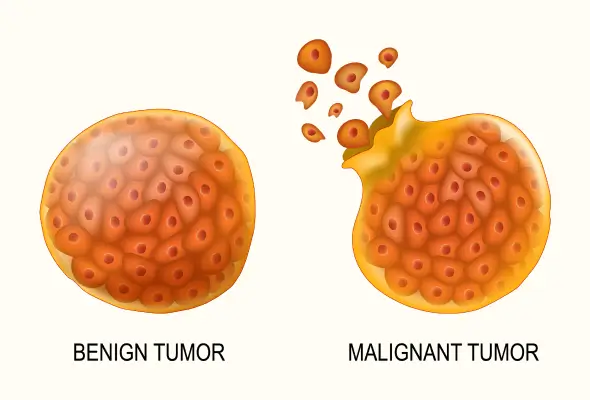-
Doctors
-
Specialities & Treatments
Centre of Excellence
Specialties
Treatments and Procedures
Hospitals & Directions HyderabadCARE Hospitals, Banjara Hills CARE Outpatient Centre, Banjara Hills CARE Hospitals, HITEC City CARE Hospitals, Nampally Gurunanak CARE Hospitals, Musheerabad CARE Hospitals Outpatient Centre, HITEC City CARE Hospitals, Malakpet
HyderabadCARE Hospitals, Banjara Hills CARE Outpatient Centre, Banjara Hills CARE Hospitals, HITEC City CARE Hospitals, Nampally Gurunanak CARE Hospitals, Musheerabad CARE Hospitals Outpatient Centre, HITEC City CARE Hospitals, Malakpet Raipur
Raipur
 Bhubaneswar
Bhubaneswar Visakhapatnam
Visakhapatnam
 Nagpur
Nagpur
 Indore
Indore
 Chh. Sambhajinagar
Chh. SambhajinagarClinics & Medical Centers
Book an AppointmentContact Us
Online Lab Reports
Book an Appointment
Consult Super-Specialist Doctors at CARE Hospitals

Benign Tumour
Symptom, Causes, Diagnosis and Treatment
Benign Tumour
The word "tumour" often triggers immediate concern, but not all tumours signal a life-threatening condition. A benign tumour, which occurs in many people during their lifetime, is a mass of cells that grows slowly and stays in one place without spreading to other body parts. Many people wonder if a benign tumour is cancerous, but it is a noncancerous growth. This comprehensive guide explores everything about benign tumours, including their types, symptoms, causes & treatment modalities.

What is a Benign Tumour?
A benign tumour is a noncancerous collection of cells that forms when the body's normal cell division process becomes irregular. Unlike normal cells that follow a regulated growth cycle and death, the cells in a benign tumour continue to multiply but don't die when they should. This results in a mass of extra cells that form the tumour.
These growths have several distinctive characteristics that set them apart from malignant tumours:
- Clear, well-defined borders often surrounded by a protective sac
- Slow growth pattern that's easier to monitor
- Stay in their original location without invading nearby tissues
- Don't spread to other parts of the body
- Rarely cause serious medical issues
While benign tumours are generally not life-threatening, their impact can vary depending on location. A large benign tumour might press against nearby tissues or organs, potentially causing discomfort or complications. For instance, a benign lung tumour could compress the windpipe and affect breathing.
Types of Benign Tumours
The most frequently encountered types include:
- Lipomas: These are the most common type of benign tumour in adults, typically appearing as soft, movable lumps under the skin, most often found in the neck, shoulders, back, or arms.
- Adenomas: These tumours develop in the epithelial tissue covering organs and glands. They often appear as mushroom-like growths with a stalk, commonly found in the colon as polyps.
- Fibromas: Also known as fibroids, these tumours grow in fibrous or connective tissue. They're particularly common in the uterus, where they can cause heavy bleeding and pelvic discomfort.
- Hemangiomas: These distinctive tumours develop from blood vessels, appearing as red or purple skin marks. They're often present at birth and frequently appear on the head, neck, or trunk.
- Meningiomas: These tumours form in the protective tissue around the brain and spinal cord. While generally benign, they require monitoring as they can become problematic if they grow large enough to pressurise the brain.
Symptoms of Benign Tumour
While some people may experience no noticeable signs, others might face various physical discomforts that affect their daily lives.
Common benign tumour symptoms include:
- Bleeding: Widespread with uterine fibroids
- Skin Changes: Including tiny red spots and small bumps
- Breathing Difficulties: When tumours affect airways
- Headaches and Dizziness: Often associated with brain tumours
- Loss of Appetite: Due to tumours pressing on the stomach
- Pain: Especially in cases of bone tumours
- Night Sweats and Fatigue: General symptoms that may occur
Benign Tumour Causes
While the exact cause of benign tumours often remains unknown, medical research has identified several factors contributing to their development. The fundamental issue occurs when cells in the body divide and grow excessively, with dead cells remaining instead of being replaced naturally.
Several key factors can trigger this abnormal cell growth:
- Environmental Factors: Exposure to toxins, radiation, or harmful chemicals
- Physical Trauma: Local injury to specific body areas
- Health Conditions: Inflammation or recurring infections
- Lifestyle Factors: Dietary habits and stress levels
- Genetic Predisposition: Family history of tumours
Complications of Benign Tumour
Physical Complications:
Physical complications can develop when benign tumours interact with nearby body structures. Large tumours pressing against nerves often cause considerable pain, while those near organs may interfere with normal bodily functions. For instance, a substantial benign tumour in the lung area could compress the windpipe, leading to breathing difficulties that require immediate medical attention.
Several serious complications can arise depending on the tumour's location:
- Nerve compression causes chronic pain and discomfort
- Organ dysfunction due to pressure from growing tumours
- Blood vessel compression affecting blood flow
- Structural changes in surrounding tissues
- Vision or hearing problems if located near sensory organs
Certain types of benign tumours have the potential to transform into cancerous growths. For example, some colon polyps may develop into cancer over time. This possibility makes regular monitoring essential, even for seemingly harmless tumours.
Diagnosis
The diagnostic process typically involves several key steps. Modern medical technology offers various imaging options:
- CT scans and MRI: These create detailed images of structures inside the body, helping doctors identify tumour location and size
- Ultrasound: Particularly useful for examining soft tissue tumours and distinguishing between solid masses and fluid-filled cysts
- X-rays: Commonly used for examining bone-related tumours and providing initial screening
- Biopsy: A biopsy often serves as the definitive diagnostic tool, allowing pathologists to examine the tumour cells under a microscope. During this procedure, doctors remove a small tissue sample using various techniques. The most common biopsy methods include fine-needle aspiration, which uses a thin needle to extract cells, and core needle biopsy, which removes a larger tissue sample.
Benign Tumour Treatment
Watchful Waiting: Many benign tumours don't require immediate intervention. In these cases, doctors often recommend watchful waiting, where they schedule regular follow-ups to monitor any changes in the tumour's size or behaviour. This approach is particularly common for small tumours that aren't causing symptoms or health complications.
When treatment is necessary, doctors may recommend several options:
- Surgery: The most common treatment approach, especially for tumours causing symptoms. Doctors often use minimally invasive techniques requiring small incisions, which lead to faster recovery times.
- Medication: Doctors may prescribe medications to manage pain or swelling symptoms. Some medications, including steroids, can help shrink certain types of tumours.
- Radiation Therapy: When surgery isn't feasible, doctors might use it to prevent tumour growth or reduce size. This treatment is beneficial for tumours in difficult-to-reach locations.
When to See a Doctor
Medical attention is significant in these situations:
- Discovery of a new lump or mass that can be felt from the outside
- Changes in a previously diagnosed benign tumour, including growth or new symptoms
- Development of pain or discomfort from an existing tumour
- Changes in the appearance of existing growths
- Interference with daily activities
- Impact on quality of life
Conclusion
Understanding benign tumours helps patients make better healthcare decisions. While these growths are typically noncancerous and slow-growing, their impact varies based on location and size. Doctors now offer multiple treatment options, from watchful waiting to minimally invasive surgeries, making the management of benign tumours more accessible than ever.
Regular medical check-ups remain crucial for anyone diagnosed with a benign tumour. Changes in size, appearance, or associated symptoms should prompt immediate medical attention. Though most benign tumours stay harmless, proper monitoring ensures early detection of any concerning changes and improves health outcomes.
FAQs
1. Is a benign tumour cancer?
A benign tumour is not cancer. Unlike malignant tumours, benign growths stay in their original location without invading surrounding tissues or spreading to other parts of the body. While they can grow larger, they maintain clear borders and typically grow more slowly than cancerous tumours.
2. Is a benign brain tumour curable?
Benign brain tumours are usually curable through surgical removal and typically don't grow back. The success rate depends on whether surgeons can safely remove the entire tumour. In cases where complete removal isn't possible, doctors may recommend:
- Regular monitoring through brain scans
- Additional treatments like radiotherapy or chemotherapy
3. Is a benign tumour painful?
Most benign tumours don't cause pain unless they press against nerves or organs. The level of discomfort depends on:
- The tumour's size
- Its location in the body
- Pressure on surrounding structures
- Impact on nearby tissues
4. What's the difference between a benign tumour and a cyst?
While both can appear as lumps, cysts and tumours are distinctly different. A cyst is a sac-like structure containing fluid, air, or other substances. In contrast, a tumour is a solid mass of tissue that forms when cells grow abnormally. While cysts often result from blocked glands or ducts, tumours develop from uncontrolled cell growth.
To Book an Appointment, call:
Still Have a Question?




